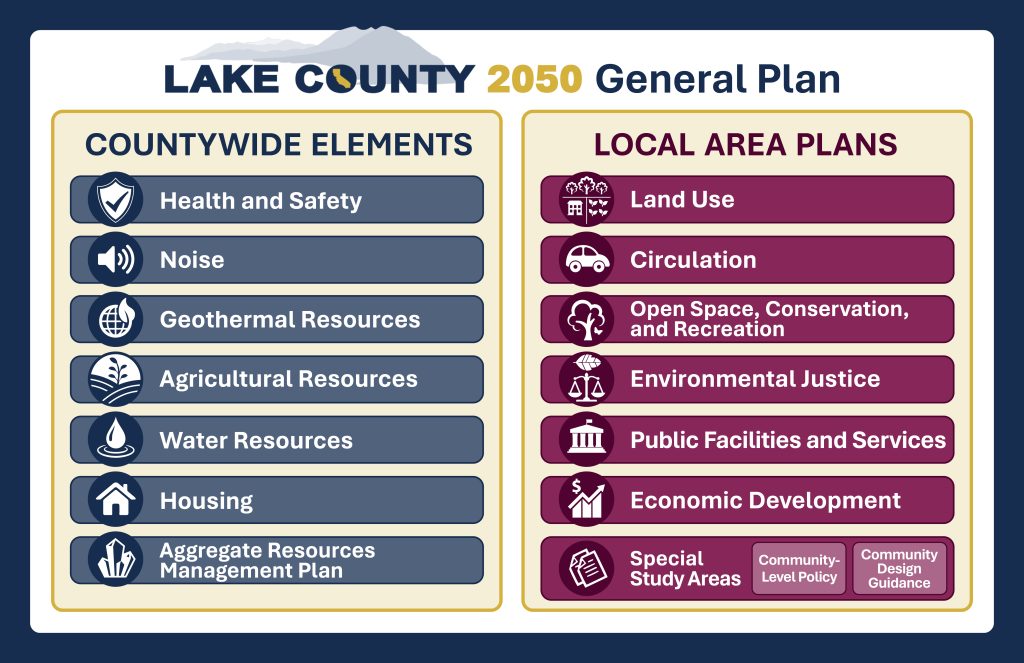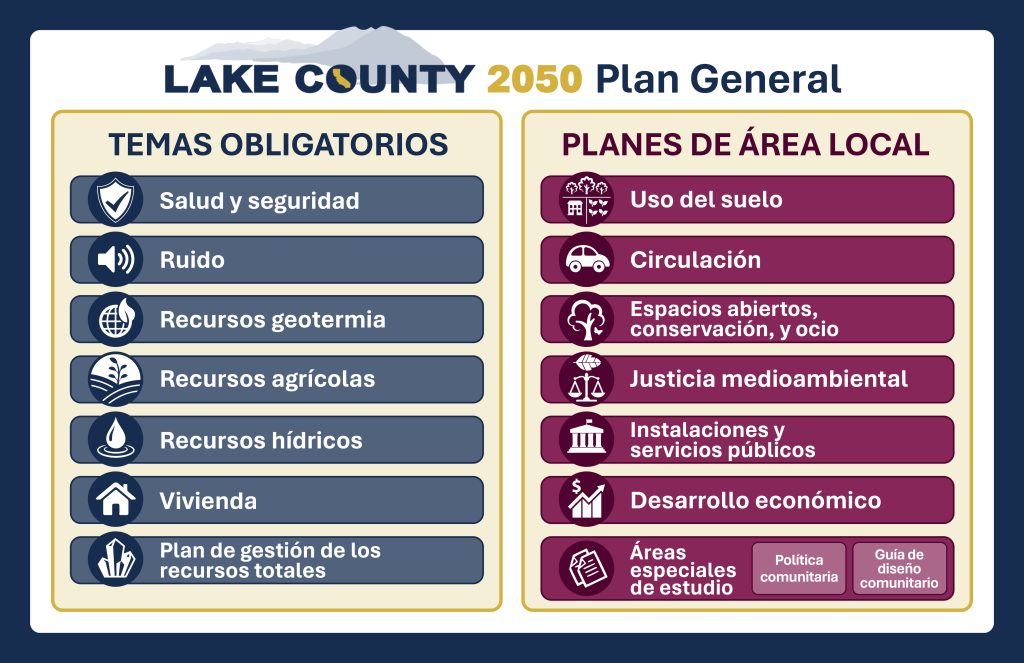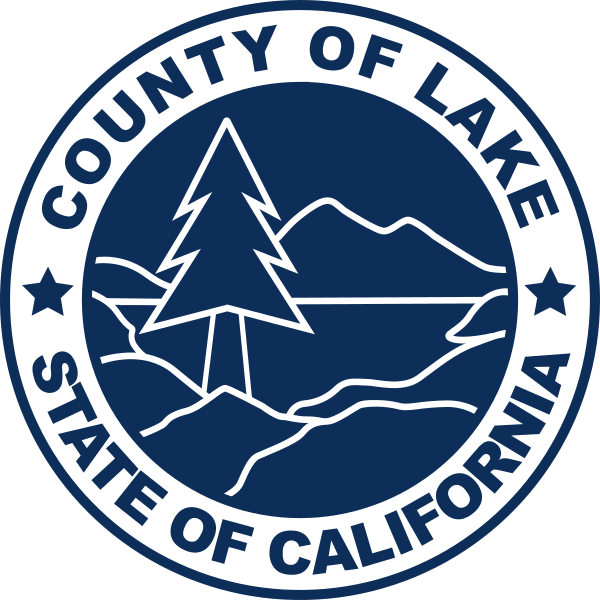General Plan Update
Background
The General Plan outlines the County’s goals for physical growth, conservation, and community life in the unincorporated area, and contains the policies and actions necessary to achieve those goals.
County staff and decision-makers use the General Plan to guide decisions about zoning, permitted development, provision of public services, and transportation improvements. Lake County’s current General Plan was adopted in 2008, and its eight Local Area Plans were adopted at various times between 1989 and 2010. Since these plans were adopted, conditions have evolved, and a comprehensive update is needed to respond to current concerns about sustainability, safety and resilience, housing, and environmental justice, while carrying forward enduring County values like preserving and celebrating agriculture and the unique character of individual communities.
Typically, a General Plan begins with a Vision Statement and then establishes specific goals and policies related to a range of civic issues. These issues are organized into a series of topic-specific “Elements” or Chapters of the General Plan. State law requires General Plans to address the following broad topics: land use, open space, circulation, housing, conservation, safety, noise, and environmental justice. These topics can be combined or presented in any order that best fits the community. Additional topics can be covered in the General Plan, depending on local needs and goals and required topics can be combined with one another. Incorporated cities are required to adopt their own General Plans.
Updated General Plan
The current General Plan, discussed in more detail below, addresses all required elements at the countywide scale. Local Area Plans cover similar topics, provide policy guidance specific to each region of the county, and are considered supplemental to the General Plan. The Lake County 2050 General Plan Update will reorganize the General Plan to avoid redundancy and streamline content. Some of the General Plan topics are best planned at a localized scale and will only be addressed within the Local Area Plans, while other topics will be addressed in Countywide Elements. The following graphics, presented in English and Spanish, provide a general overview of how the General Plan will be organized.


Current General Plan
Apart from environmental justice, which is a new topic required by State law, the current General Plan addresses all State-required Elements (referred to as Chapters in the existing Lake County General Plan), plus some optional topics, as described below.
- Land Use. Establishes a comprehensive set of goals, policies, and implementation measures to guide the future use and development of land in unincorporated Lake County. The Land Use Diagram and Density / Intensity Standards are critical parts of this Element, identifying allowed land uses and development standards on all unincorporated parcels in the county. This Element also presents Community Growth Boundaries that limit urban development around established communities.
- Housing. Identifies significant issues associated with the provision of housing in Lake County. Provides a strategy that establishes housing goals, policies, and implementation programs intended to give direction to meet current and future housing needs of the county, both in terms of preservation of existing housing stock and in establishing priorities for new construction. [Note: As required by State law, the Housing Element is updated on a separate schedule from the rest of the General Plan. The current Housing Element was adopted in 2019 and is valid through 2027.]
- Public Facilities and Services. Establishes goals and policies that address the vital infrastructure and public services which are needed to maintain a high-level quality of life for current and future Lake County residents. Civic and public facilities are included in this Element.
- Transportation and Circulation. Describes existing and proposed roadways and other means of transportation such as public transit, bikeways, and pedestrian routes. Analyzes traffic conditions and needed improvements so that existing and projected circulation needs may be adequately met.
- Health and Safety. Establishes goals and policies to minimize risk to people and property from natural and human-caused hazards. This includes discussion of emergency response goals and policies that would maintain the Emergency Operations Plan for the County. Additionally, the work to prepare this Element will include preparation of a Climate Vulnerability Analysis and Countywide Evacuation Plan.
- Noise. Seeks to control environmental noise and protect the community from excessive noise exposure.
- Open Space, Conservation, and Recreation. Sets goals and policies that protect and enhance the natural and cultural resources that make Lake County unique. This includes biological and scenic resources, as well as specific policies around Clear Lake, the County’s single most valuable natural resource.
- Geothermal Resources. Encourages research and development, protection, utilization, and collaboration around the geothermal resources in Lake County.
- Water Resources. Addresses a range of water-related issues in Lake County, working to protect and sustain Lake County’s surface and groundwater resources.
- Agricultural Resources. Seeks to protect and enhance agricultural resources as a vital component of the county’s economy and quality of life.
- Aggregate Resources Management Plan. Provides context and policies for aggregate mining operations in Lake County. [Note: The Aggregate Resources Management Plan is included in the current General Plan as Appendix A and was adopted in 1992; the update to this document will be a separate task and is not included in the Lake County 2050 project at this time.]
Current Local Area Plans
Within Lake County, there are eight Local Area Plans, each planning for a distinct region of the county at a more localized scale than the current countywide General Plan. Together, these eight Local Area Plans cover the entire unincorporated county and provide additional guidance for decisions in each region. The Local Area Plans and the year in which each was adopted are listed below with links to the current plans.
- Lower Lake Area Plan – 1988
- Cobb Mountain Area Plan – 1989
- Kelseyville Area Plan – 1995
- Lakeport Area Plan – 2000
- Upper Lake-Nice Area Plan – 2002
- Rivieras Area Plan – 2007
- Shoreline Communities Area Plan – 2009
- Middletown Area Plan – 2010
View the members of each LAPAC here.
Environmental Review
The California Environmental Quality Act (CEQA) requires the County to conduct a thorough analysis of the potential physical environmental impacts of implementing the updated General Plan to inform decision makers and the public where significant impacts would be, and methods to reduce those impacts to the extent feasible. The County will prepare an Environmental Impact Report, or EIR, which will include an analysis of each of the CEQA Guidelines Appendix G, Environmental Checklist, topic areas. The EIR will also include identification of baseline conditions; thresholds of significance; range of reasonable alternatives; cumulative impact analysis; growth‐related impact discussion; description of significant effects of the proposed project on the environment; and mitigation measures proposed to avoid, minimize, rectify, reduce, eliminate, or compensate for any identified significant impacts. This programmatic EIR will be used to evaluate the impacts of the General Plan Update; future individual development projects would still need to complete project-specific CEQA reviews.
Climate Adaptation Plan
The Climate Adaptation Plan (CAP), funded by the State’s Adaptation Planning Grant Program, will include development of an adaptation framework for both unincorporated Lake County and the cities of Clearlake and Lakeport. The CAP process will identify problem statements based on the Climate Vulnerability Assessment, which will be prepared as part of the update to the Health and Safety Element. The CAP will determine Focus Areas for targeting places, assets, and people with the highest needs and vulnerabilities, for the development of specific climate adaptation goals and strategies. During this process, the County will engage the community and stakeholders through an inclusive, transparent, and collaborative process to learn about lived experiences in adaptation and gain local knowledge of resilience practices to ensure the CAP builds off existing adaptation efforts and improves the resilience of all communities in the county.
Related Efforts
Housing Action and Implementation Plan
The Housing Action and Implementation Plan (HAIP), funded by the American Rescue Plan Act (ARPA) will be a comprehensive manual with action steps to address the current and forecasted housing demand throughout Lake County. It is related to, but not a part of the General Plan. However, it will serve as a foundation for the County’s 2027-2035 Housing Element Update, which will be a part of the General Plan. The HAIP will analyze demographic trends, market forces that shape the development and real estate industries, and challenges such as wildfire and the availability of utilities. Policies, regulations and development approval processes in the County of Lake, Lakeport and Clearlake will be evaluated. An inventory of sites that are suitable for residential development will be prepared. The HAIP process will incorporate input from a broad spectrum of community members to identify the needs of the community, understand opportunities and constraints and establish strategies to preserve the current housing stock and develop new housing options. The HAIP will provide decision makers and the community with action steps and information on partnerships, funding and resources to implement the identified strategies.

